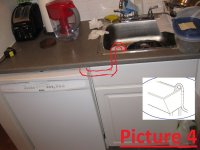Toto
New Member
Hello,
I am happy that I found this forum. But I am not a pro, so I did not understand all of the stuff that I have read here so far, and could not find a solution to the problem that I face. So I hope you could help me.
I would like to install a 24'' front load washer in the place of the dishwasher in the kitchen area of my apartment. I was very happy when the landlord gave his permission under the condition the washer to be installed by a professional plumber. But it seems to me now that I was happy too early, as I had no idea what a professional installation meant and had no idea that such a thing as a Plumbing Code existed as well. (The problem with the code in particular is that it is not publicly accessible - I will have to buy it in order to even have a chance to try to read in and see if I even have a problem with it).
So once I had the landlord's permission I ordered the 24'' wide compact washer, which would fit under my counter. I thought that since the compact washer was designed to fit under a kitchen counter, and the manual of the washer was asking for a 1 1/4 '' standpipe for drainage, then there would be no problem to hook the washer, because the drain pipe under the sink is larger than that. I believed that the pipes draining my kitchen sink were 2'', but I was measuring them on the outside and later discovered that this most likely translates to 1 3/4''. But this is still by 1/2'' larger than the minimum requirement for the washer.
However, several plumbers I contacted said they could not do the installation or that it can not be done at all. Only one or two mentioned that it can't be done because the drain pipes I have are less than 2''. So I am desperate to find a plumber who could do the job. I would appreciate it if you could give your opinion if the washer can be installed and suggestions on how this can be done. I can not do permanent modifications to the kitchen cabinets or the walls behind them that can not be replaced / repaired after I move out. I hope that from the pictures you will be able to see what I mean and what are my ideas. My favorite is on pic 3 - the sink siphon connection.





I am happy that I found this forum. But I am not a pro, so I did not understand all of the stuff that I have read here so far, and could not find a solution to the problem that I face. So I hope you could help me.
I would like to install a 24'' front load washer in the place of the dishwasher in the kitchen area of my apartment. I was very happy when the landlord gave his permission under the condition the washer to be installed by a professional plumber. But it seems to me now that I was happy too early, as I had no idea what a professional installation meant and had no idea that such a thing as a Plumbing Code existed as well. (The problem with the code in particular is that it is not publicly accessible - I will have to buy it in order to even have a chance to try to read in and see if I even have a problem with it).
So once I had the landlord's permission I ordered the 24'' wide compact washer, which would fit under my counter. I thought that since the compact washer was designed to fit under a kitchen counter, and the manual of the washer was asking for a 1 1/4 '' standpipe for drainage, then there would be no problem to hook the washer, because the drain pipe under the sink is larger than that. I believed that the pipes draining my kitchen sink were 2'', but I was measuring them on the outside and later discovered that this most likely translates to 1 3/4''. But this is still by 1/2'' larger than the minimum requirement for the washer.
However, several plumbers I contacted said they could not do the installation or that it can not be done at all. Only one or two mentioned that it can't be done because the drain pipes I have are less than 2''. So I am desperate to find a plumber who could do the job. I would appreciate it if you could give your opinion if the washer can be installed and suggestions on how this can be done. I can not do permanent modifications to the kitchen cabinets or the walls behind them that can not be replaced / repaired after I move out. I hope that from the pictures you will be able to see what I mean and what are my ideas. My favorite is on pic 3 - the sink siphon connection.

